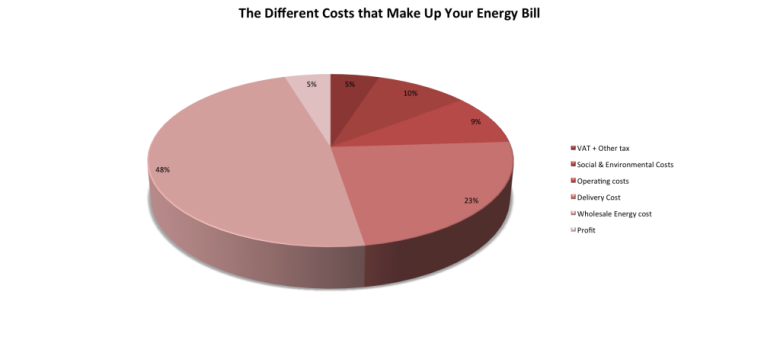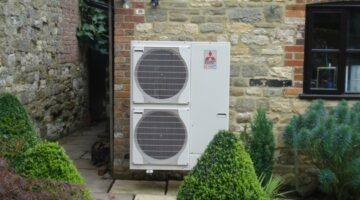
Wholesale Energy costs
So, starting with the main component of your energy bill; the wholesale energy cost is the price of electricity and gas that energy retailers (British Gas, E.ON, Npower, etc) buy from the energy market. This makes up by far the biggest element of the energy bill – about 48% averaged across the big six energy companies, which on a bill of £1300 a year comes to about £620.
The energy companies have to secure the energy ahead of actually providing it to customers, and this is done by buying it well in advance (sometimes as much as two years) to ensure that supply is not disrupted.
All of the Big Six energy retailers: EDF, E.ON, British Gas, Scottish Power, Npower, SSE, also have generation businesses, which means they have some generating (electricity) and extraction (natural gas) capacity. However this generating and extraction capacity doesn’t unfortunately stop them from having to purchase additional energy to satisfy the demand from customers.
So although they blame the increases in wholesale prices as the reason for increasing the price of the customer’s bill, in theory they are paying themselves twice – increasing the profits of their generation and extraction businesses (which also part of the wholesale price) and then passing on any increases in the market price to homes and businesses. So their increased cost effectively turns into increased revenue twice over. It’s no surprise that the generation and extraction businesses are the most profitable parts of their business portfolios but are ‘glossed over’ and poorly understood by the press and politicians.
The companies say there is strict separation between the different parts of the business – the retail side (selling to you and me) and the generation side (sourcing the energy); and they also tell us they don’t come together and collude on price rises, but when you begin to understand how they operate you begin to wonder what they announce publicly actually stacks up!
One final point is that electricity is generated all over the UK and demand for electricity doesn’t always match the demand. Therefore there is a need to move the electricity around the distribution network to ensure customers can get the electricity when it is needed. The National grid carries out this job and they recover their costs from suppliers through this ‘wholesale energy cost’ element of the bill – this is known as the Balancing Services Use of System.
The Energy Delivery Network
Transmission and distribution is the second largest component of your energy bill. This is the price paid by the energy suppliers to the companies that operate the energy distribution networks. This makes up about 24% of your energy bill and the price paid is determined by OFGEM (the energy regulation body) in conjunction with the energy distribution companies (like National Grid, Scotia Gas Networks, UK Power Networks, etc).
These prices are rising since investment is also increasing as the old network has to be upgraded to ensure that the distribution infrastructure can cope with increases in demand and continue to deliver an uninterrupted energy supply to our homes and businesses.
For example old gas pipework is being replaced by new more robust materials, which means roads need to be dug up and new infrastructure put in place. Also a new power station or wind farm will require new cabling to get the electricity from where it is produced to where it is needed, and this is what is responsible for this component of the bill going up.
Social & Environmental Costs
Social and Environmental costs make up just under 10% of your energy bill, so on an average bill of £1,300, you are paying about £130 towards this element. Despite only being a tiny portion of your bill relative to the other components, this component has been the one that has created the most media attention since this is the one the Government have a real say in.
The background to this component is that the Government have now made it a legal requirement for the energy companies to provide help to vulnerable members of society to ensure they have access to heat and electricity and to try and make this more affordable to them. There are numerous schemes running that the Government enforces to help achieve this and we have detailed a few of them below.
These schemes target in particular elderly customers, customers with disabilities and low-income families that require an extra bit of help. The first example is the Winter Fuel Payment, which provides a tax-free payment of between £100- £300 to any homeowner who was born prior to 5th January 1952. This can also be topped up by an additional £25 Cold Weather Payment for those particularly cold winter weeks.
Another scheme that is in place to try and tackle the root causes of heating and insulation problems is the ECO or the Energy Company Obligation. You can read more about this scheme her but in a nutshell this helps drive energy efficiency among this same group of vulnerable members of society, where if it was left to the market, would priced out and excluded.
Measures available through ECO include new boilers, cavity and loft insulation and solid wall insulation, have click here to see if you can take advantage of this.
So as customers we have to decide where our priorities lie and whether we want to help continue protecting the most vulnerable. As a nation we have always done this, and I expect we will continue to do so! Whether we do this through energy bills or general taxation is another argument altogether.
Finally, the Government also have put in place policies in place to help the UK adhere to its legally binding carbon reduction program. This includes the subsidies that are paid when wind farms are built or solar panels are put on your roof. Despite a few media outlets (see the Telegraph for example!) being incredibly critical of this kind of investment – these renewable technologies will ensure that the amount of energy we need to import from places like Qatar or Norway is massively reduced, which gives us a bit of energy independence and therefore protects us from price volatility but this obviously a longer term view!
Tax
This is simply tax paid either as VAT or corporation tax – and is roughly 5%.
Operating costs
Most big companies have overheads to keep the business running, like having to pay wages. If you think that the energy companies are providing a service to many millions of customers unfortunately there is not much they can do here to pass on any savings to us! Even if top management of the biggest salaries were to be paid less, this would be a drop in the ocean sadly. The operating costs represent about 10% of the energy bill you pay.
Profit
All the energy companies claim they are making a fair profit – which is roughly 5% across the board. They claim that this kind of profit is broadly in line with supermarkets, another of life’s necessities and since they are all publicly listed, they pay a dividend that helps boost pension funds. They also claim that they are investing in new power plants to replace ageing infrastructure, but to be honest I am yet to see materialise on a grand scale, but that may just be me being cynical!
Conclusion
So there you have it – hopefully everything you need to know about how energy bills are made up. I hope this gives you enough information to reach your own conclusion whether you feel the 10% annual increases are justified. It seems to me that although wholesale costs do go up, the energy companies have not come clean on the vast profits their businesses bring in. It is only when we have full transparency that we will see the tide of trust begin to turn.
To see a pie chart showing the energy bill breakdown please click here
To read some more of our ‘bigger picture blogs – click here – a great read over lunch!












This is a very interesting piece – I have always wondered why I pay so much! Please keep up the good work, I love your blog!
PS. I didn’t know about the cold weather payments – I must look into that, I have heard it is going to be a very cold winter (at least that is what the express tells me!!)